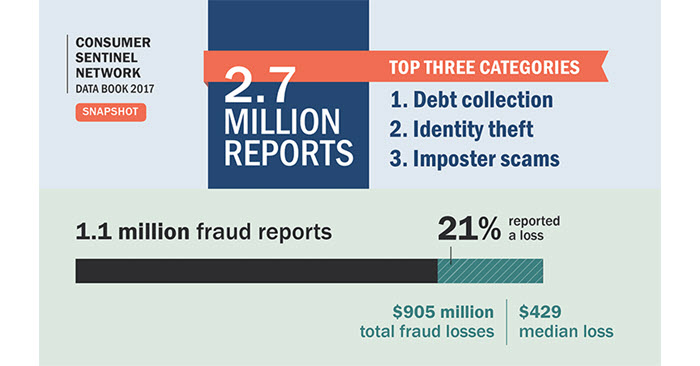The Federal Trade Commission (FTC) released its annual Consumer Sentinel Data Book summarizing consumer complaints about fraud, identity theft and other consumer concerns. While the number of complaints about fraud from consumers dropped in 2017, consumers reported losing more money than they did in 2016.
The FTC takes in reports from consumers about problems they experience in the marketplace. The reports are stored in the Consumer Sentinel Network (Sentinel), a secure online database available only to law enforcement.
The FTC’s 2017 Consumer Sentinel Network Data Book includes complaints from 2.68 million consumers, a decrease from 2016 when 2.98 million consumers submitted reports about fraud, identity theft and other types of consumer concerns. Despite this, consumers reported losing a total of $905 million to fraud in 2017 — $63 million more than in 2016.
Although reports about debt collection declined between 2016 and 2017, it remained the top consumer complaint category, making up about 23 percent of all complaints. The high number of debt collection reports was due in part to reports submitted by a data contributor who collects complaints via a mobile app.
Identity theft was the second biggest category, making up nearly 14 percent of all the consumer complaints. Credit card fraud was the most common type of identity theft reported by consumers. Tax fraud was the second most common type of identity theft reported by consumers despite falling by 46 percent from 2016.
“While we received fewer overall complaints in 2017, consumers reported losing more money to fraud than they did the year before. This underscores the importance of the FTC’s work in educating consumers and cracking down on the scammers who try to take their money.” — Tom Pahl, Acting Director of the FTC’s Bureau of Consumer Protection.
For the first time, the 2017 data book includes details on fraud losses broken out by age groups, as reported by consumers. Consumers in their twenties reporting losing money to fraud more often than those over age 70. For example, among people aged 20-29 who reported fraud, 40 percent indicated they lost money. In comparison, just 18 percent of those 70 and older who reported fraud indicated they lost any money. Then these older adults did report losing money to a scammer, the median amount lost was greater. The median reported loss for people age 80 and older was $1,092 compared to $400 for those aged 20-29.
Imposter scams were the third most common consumer complaint. Consumers reported losing substantially more money to imposter scams – a total of $328 million – than any other type of fraud. Imposter scams involve someone pretending to be a government official, tech support representative, a loved one in trouble or someone else in order to get consumers to give the scammer money. Nearly one in five consumers who reported an imposter scam indicated they lost money to the fraud.
When looking at all types of fraud, the median loss from fraud in 2017 was $429. People who reported travel, vacation and timeshare fraud reported losing a median amount of $1,710 – the highest individual loss amount compared with other scams. Military consumers reported losing the most money to imposter scams ($26 million in total). The median fraud losses reported by members of the military were more than 44 percent higher than the general population, with military consumers reporting a median fraud loss of $619.
As in past years, fraud reports indicated that wire transfer was the most widely used form of payment, and 70 percent of consumers reported that scammers contacted them by phone.
The data book includes national statistics, as well as a state-by-state listing of top report categories in each state, and a listing of metropolitan areas that generated the most complaints per capita.
The top states in 2017 reporting fraud were:
- Florida
- Georgia
- Nevada
The top states in 2017 reporting identity theft, per capita:
- Michigan
- Florida
- California
The FTC produces the Consumer Sentinel Network Data Book annually using reports received by the Consumer Sentinel Network. These include reports made directly by consumers to the FTC, as well as reports received by state and federal law enforcement agencies, national consumer protection organizations, and non-governmental organizations.
This year the FTC has developed a mini site available at ftc.gov/sentinel2017 to make the information in the 2017 data book more accessible for the public, such as providing a webpage for each state.
